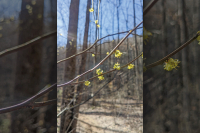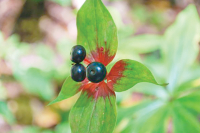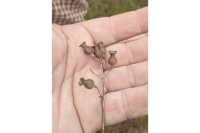Up Moses Creek: ‘When, Wren?’
 A male Carolina wren sings up to 3000 times a day.
Fred Coyle photo
A male Carolina wren sings up to 3000 times a day.
Fred Coyle photo
Finally, we can go out the back door again. For a month we made a front door detour around an unplanned construction project on the back porch.
We first noticed something a-buildin’ there when the yard wrens started to fly in with pine needles, moss and leaves and shape them into a nest. The nest was inside a basin of Becky’s gardening tools on a shelf beside the door. Her trowel’s wood handle served as the entrance lintel.
For the wrens it was a convenient spot, protected under the roof. But once the female laid her eggs — five little white ones with reddish speckles — our back door goings and comings became inconvenient. “Go around!” she scolded. Her nest had only one opening. Our house had more than one.
Meanwhile, the male, perched on a garden post, sang, “I’m here! I’m here! I’m here!” We’d seen the wren pair build nests in years past, including in the clothespin bag on the line, and in one of my canoes, but the way the male sang this time, you’d think he’d never been a parent-to-be before. With his tail pointed down and his beak pointed up, he sang with his whole body, “I’m here!” He sang the sun up and the sun down, while his mate peered out of the nest and brooded the eggs.
Although the eggs were laid in April, our front door detour lasted a February month: 14 days for incubation and 14 for the hatchlings to fledge. Snakes and raccoons didn’t find the morsels — easy to reach on the shelf — and a prowling tomcat didn’t spot the mother and leap.
I looked in from time to time when the female was away, and each time I’d see that she’d nudged the eggs into a new configuration, as if she were stirring a pot to make sure the contents received equal heat.
Related Items
On the 14th day, I found that what had been a cluster of perfectly formed and distinct eggs was now a confused pile of pink pot bellies with skinny necks ending in yellow beaks flanked by dark bulges — the still-closed eyes — and topped with cowlicks of down.
The ungainly contraptions seemed to know just one thing — how to gape for food. At first, they even gaped when my face appeared at the door, showing me their blaze-orange mouths.
Both parents came almost nonstop after that with caterpillars dangling from their beaks. Butterflies too. We saw one wren knock down a tiger swallowtail and beat it until its buttery wings lay tattered on the ground. Then it carried the limp body to the young to nourish their growing wings.
Fourteen days from hatching, the chicks were fully formed and feathered. Their glistening eyes were open, black and wild. They filled the nest to overflowing, and when the parents came with food, they craned their beaks —“Me first!”
I craned my neck too, eager to see the moment of first flight. But at sight of me, the young ones squeezed back in lay still.
I ate a sandwich, then, looking again, yelled back into the house —“They’re gone!” Although the nest was packed with young birds just a sandwich ago, now it was completely empty. Not even a feather remained.
Yes, the young were gone — but not far-gotten. To judge by the pepperbush in the yard — its leaves shaking with noisy commotion — the whole family was inside. Suddenly, a youngster appeared on a nearby rock wall. The mother was there in a flash dangling a caterpillar to draw the stray back into the bush.
Later, I happened on the fledglings as they emerged one by one from under the bush. They hopped innocently across the gravel drive like little feathery Adams and Eves in Eden. One stood over a big black ant and, cocking its head, gave it a significant look. Another watched in dumb wonder as the parents strafed an approaching chipmunk—its introduction to the fallen world.
The family disappeared into the woods after that, and then Becky and I were away on a canoe trip. But, home again, and 31 days after the April fledging, we were in the back yard and noticed a wren flying in and out of the end of one of my canoes, stored upside down on a rack in the shelter. Peering in with a flashlight, I saw a nest. Then four gaping yellow beaks rose into sight.
Burt and Becky Kornegay live in Jackson County.













